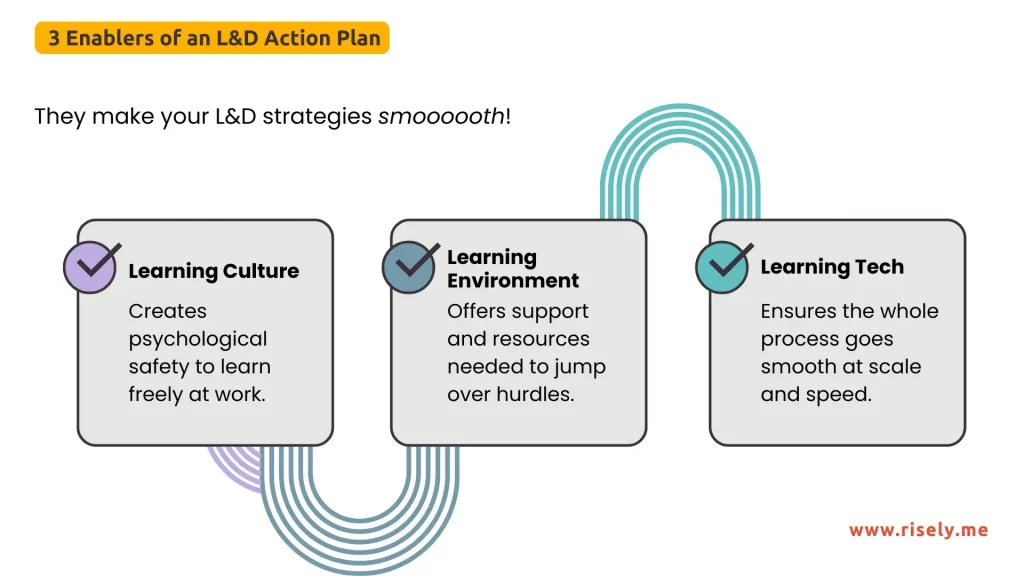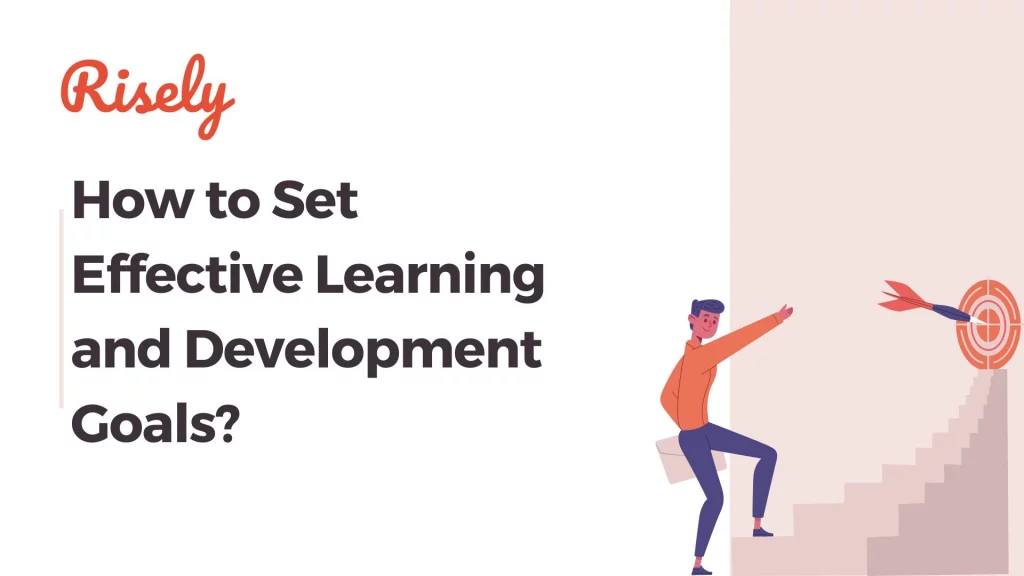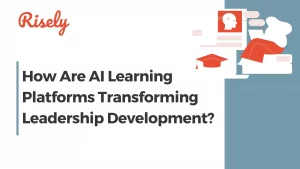How to Set Effective Learning and Development Goals?
For L&D teams, setting the right goals isn’t just about training—it’s about driving real impact and aligning with the broader strategic vision of the organization. Effective learning and development goals should focus on demonstrating value, securing a seat at the table as a strategic partner, and ensuring your initiatives are recognized without having to constantly fight for budgets. By establishing clear, measurable objectives, you not only improve skills and performance across the organization but also solidify the importance of L&D in achieving long-term business success. This blog highlights how effective learning and development goals are set, why is setting them important for your organization and what challenges you might face during this process.Why do we Need Learning and Development Goals?
Learning and development goals are vital for growth—both for your team and your organization. For employees, these goals offer a clear path to gaining new skills and knowledge that can fast-track their career progression. When individuals are in control of their own growth, it boosts job satisfaction and unlocks new opportunities, empowering them to thrive in their roles. For organizations, setting clear learning and development goals ensures that training efforts are aligned with strategic objectives. This way, every investment in development delivers measurable impact, driving business success. Plus, it fosters a culture of continuous learning, building a workforce that’s not only skilled and adaptable but also fully engaged and ready to take on future challenges. Above all, you will be better able to show the stakeholders the impact of your training programs if you establish clear learning and development goals. Another advantage of establishing clear goals is that it allows you to work together and integrate your strategies with other departments, as well as gain a seat with the CXOs.How do you align Learning and Development goals with business strategy?
Aligning learning and development goals with your organization’s business strategy is essential for maximizing impact. Developing an effective learning and development strategy entails establishing a culture of learning for your team, providing resources and support in the learning environment, and, for maximum effect, embracing technology.
What are the Key Learning and Development Areas?
The key areas of learning and development are all about equipping your team with the skills and knowledge they need to thrive in their roles while driving the success of your organization. These areas typically include a combination of technical expertise, leadership and management skills, and essential soft skills like communication and adaptability. To identify the right focus for L&D, it’s important to take a closer look at both current and future needs. Consider the organization’s strategic goals, emerging industry trends in L&D, and the personal growth aspirations of your employees. By aligning these elements, you create a learning and development plan that not only fills skill gaps but also keeps your team prepared for the challenges and opportunities ahead, ensuring continuous progress and success for both individuals and the company. Following are the key learning and development areas that your team would want to work on:Technical Skills and Knowledge Enhancement
With technology advancing rapidly, keeping technical skills up-to-date is more important than ever. Employees need to continually learn and adapt to meet the evolving demands of their roles. This involves:- Mastering new software or programming languages
- Enhancing skills in data analysis and interpretation
- Embracing cutting-edge technologies like AI, machine learning, or automation
Leadership and Management Development
Effective leadership is important to guide teams, inspire good performance, and achieve success for organizations. Building strong leadership skills is a continuous process that needs careful focus. Leadership and management development programs should aim to improve:- Communication and delegation skills
- Strategic thinking and decision-making abilities
- Emotional intelligence and conflict resolution techniques
Soft Skills Improvement for Team Success
Soft skills, often called people skills, are crucial for building strong relationships, communicating effectively, and driving team success. Unlike technical skills, which focus on specific tasks, soft skills revolve around how individuals interact and collaborate with each other. Below are some major soft skills to focus on:- Communication Skills: This encompasses active listening, clear and articulate speech, and effective written communication.
- Teamwork: Building the ability to collaborate with others, resolve conflicts, and work towards shared goals.
- Problem-Solving and Critical Thinking: Developing the ability to tackle challenges and think creatively.
- Adaptability and Flexibility: Being open to change and able to adjust to new situations.
Setting SMART Learning and Development Goals
The SMART goals framework is an invaluable tool for crafting clear and actionable objectives. SMART stands for Specific, Measurable, Achievable, Relevant, and Time-Bound. This method ensures that your goals are not just well-defined but also trackable and attainable. When applying the SMART framework to your learning and development goals, you create objectives that are manageable and aligned with your broader strategy. This approach provides clear metrics for tracking progress, ensures goals are realistic given your resources, and sets deadlines to foster urgency and direction. This clarity and focus transform your goals into actionable steps toward success.Specific Goals for Targeted Learning Outcomes
Being specific is key to setting effective SMART goals. Vague goals hinder progress. Instead of saying, “Improve communication skills,” specify, “Deliver a strong presentation to the team within the next three months.” This specificity turns broad career ambitions into actionable steps, helping you understand exactly what needs to be done. It also encourages you to seek out the necessary resources and support.Measurable Objectives to Gauge Progress
Tracking progress is crucial for maintaining motivation and recognizing achievements. Measurable goals involve clear metrics to assess the effectiveness of your learning and development efforts. For instance, rather than stating, “Learn a new programming language,” set a measurable goal like, “Complete a certified Python course and successfully develop a basic app within six months.” This provides a clear target and allows you to adjust your approach as needed. Regularly reviewing these measurable goals enhances the L&D process, maximizing the impact of your training and development efforts.Achievable Aspirations that Motivate Teams
While challenging goals are motivating, they must also be realistic and attainable. Setting overly ambitious goals can lead to frustration and decreased motivation. For instance, if a team member’s goal is to improve their project management skills, an achievable aspiration might be to “Complete a project management certification course and apply the new skills to manage a small-scale project within the next six months.” This goal is challenging but attainable, allowing the team member to gradually build their skills and confidence. When team members see that their efforts contribute to meaningful objectives, they become more engaged and committed to their growth. This fosters a culture of continuous learning, where individuals are motivated to acquire new skills and knowledge, knowing their efforts are valued and impactful.Relevant Learning Goals Aligned with Organizational Needs
Relevance is essential in L&D. Goals should align with both individual career aspirations and the organization’s strategic objectives. Relevant goals ensure that professional development contributes to the company’s success. For example, if a company aims to enhance customer satisfaction, relevant learning and development goals might include improving customer service skills, developing active listening abilities, or mastering customer relationship management (CRM) software. Aligning L&D goals with organizational needs turns training into a strategic investment rather than a mere expense.Time-Bound Targets to Ensure Timely Achievement
Deadlines are crucial for maintaining focus and accountability. Without a set timeframe, goals can be overlooked or deprioritized. By establishing deadlines, you enhance time management and ensure timely progress. Instead of simply stating, “Improve presentation skills,” a more effective goal would be, “Complete a public speaking workshop and deliver a presentation at the next team meeting in two months.” This approach drives action and helps you use your time efficiently to achieve your learning and development objectives. Regularly revisiting these goals keeps you focused and on track.Track Goals Easily with Risely’s free SMART Goals Template!
Learn how to turn every goal smarter and achieve it in quick steps with practical guidance.
What are some SMART examples of L&D goals?
| Area | L&D Goal Example |
|---|---|
| Technical Skills | Complete a certification course in data analysis software by Q2 2024. |
| Leadership Development | Participate in a leadership development program and mentor a junior colleague by the end of the year. |
| Soft Skills | Attend a workshop on active listening and conflict resolution within the next six months. |
| Customer Service | Achieve a 90% customer satisfaction rating within the next performance cycle. |
How to Overcome the Common Challenges in Setting L&D Goals?
Many organizations recognize the value of Learning and Development (L&D), but they often encounter hurdles when setting and achieving effective goals. Below are the challenges that you might face and solutions to overcome them:1. Budget Constraints and Resource Allocation
Securing sufficient budget and resources for L&D can be tough, especially in competitive industries where the return on investment might not be immediately clear. Focus on training programs that address crucial skill gaps and align with your main objectives. Consider cost-effective solutions like online learning platforms, and using AI-driven platforms like Risely’s feature called Merlin- an AI Leadership Coach that provides one-on-one coaching at a fraction of the price of general coaching. Also, explore options like giving employees a personal training budget to encourage self-directed growth. With smart planning and resource management, you can maximize the impact of your L&D efforts, even with limited funds.2. Ensuring Stakeholder Buy-In and Support
Gaining support from both stakeholders and employees is essential for the success of any L&D initiative. Stakeholders may question the immediate benefits, while employees might feel overwhelmed by their existing workload. Effective communication on how L&D programs help in achieving company goals and address key business needs should be done to resolve this. Involve stakeholders early on, share success stories that demonstrate the positive impact of training, and keep everyone updated on progress and results. Open communication and showcasing the tangible benefits of L&D will help build trust and foster a supportive environment.3. Balancing Immediate Needs with Long-Term Aspirations
It is tempting to focus solely on addressing immediate skill gaps, but this might limit your organization’s ability to adapt and grow in the long run. Strive for a balance by addressing urgent skill needs with targeted training while also investing in programs that prepare for future challenges and build leadership capabilities. Encourage a culture of continuous learning that supports both short-term needs and long-term development. This balanced approach ensures that your workforce remains agile, skilled, and ready to tackle both current and future demands effectively.Tools and Resources for L&D Goal Setting
The process of setting and tracking the L&D goals is pretty easy with proper tools and resources. Here’s how you can streamline the process:Leveraging Technology for Learning Management
Technology is transforming how we learn and develop. Learning Management Systems (LMS) are now central to managing and delivering training programs. They help centralize learning materials, monitor progress, and provide valuable insights into training effectiveness. Beyond traditional LMS, you should explore digital tools like microlearning platforms, virtual reality (VR) simulations, and interactive learning activities to keep engagement high and aid retention. These technologies allow you to personalize learning experiences, track progress more effectively, and offer timely support.Utilizing Feedback Mechanisms for Continuous Improvement
Feedback is crucial for refining your L&D programs and ensuring they meet learners’ needs. You should regularly gather input through post-training surveys, one-on-one discussions, focus groups, or online forums. Also, creating a comfortable environment for honest feedback will assist you in making necessary adjustments and improving program relevance. By valuing and acting on feedback, you demonstrate a commitment to continuous improvement, enhancing the overall impact of your L&D initiatives. Tools like performance management systems, LMS, and goal-tracking software are essential for setting SMART goals, creating action plans, and monitoring progress. Collaboration platforms are also useful for sharing resources and best practices within your organization. Select tools that fit your team’s needs and workflow to stay organized and on track with your L&D goals.Conclusion
Setting clear learning and development goals is important for personal growth and the success of a company. When these goals match the business plan, and focus on areas like technical skills, leadership, and soft skills, teams can reach specific targets. Goals should be SMART, meaning they should be Specific, Measurable, Achievable, Relevant, and Time-bound. Even with challenges like budget limits and getting support from stakeholders, using tools like technology and feedback can improve goal setting. It is important to monitor and check progress regularly. By facing challenges and seeking continuous improvement, organizations can create a culture of learning that helps both individuals and the company grow.Avantika holds an undergrad degree in Political Science and Psychology, bringing a unique blend of analytical and psychological insight to her writing. With extensive experience in content creation and research, she crafts engaging and well-informed content that resonates with readers and drives meaningful conversations.
Setting the right goals defines the accuracy of your path to success!
Take this FREE goal-setting self-assessment by Risely now to test the efficacy of your goal-setting.
How to Build a Leadership Journey? ft. Thomas Ulbrich
Effective leadership doesn’t always begin with a grand vision. Sometimes, it takes root in the courage to take the first…
AI and Leadership Development: Driving Synergy for Growth
Sneha MishraApr 14, 2025
AI and Leadership Development: Driving Synergy for Growth You know the frustration all too well. Your organization invests thousands in…
How Are AI Learning Platforms Transforming Leadership Development?
Sneha MishraApr 8, 2025
As an L&D leader, you’re likely familiar with this frustrating reality: 82% of organizations consider leadership development critical(1), yet only…
5 Essential AI Skills for L&D Leaders
Sneha MishraMar 31, 2025
5 Essential AI Skills for L&D Leaders According to LinkedIn’s 2025 Workplace Learning Report(1), 71% of L&D professionals are now…
How to Create a Course with AI: A Guide for L&D Professionals
Sneha MishraMar 20, 2025
How to Create a Course with AI: A Guide for L&D Professionals According to a McKinsey survey(1), only 11% of…







